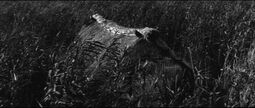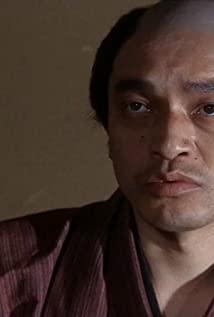In 1960, Kanto Shindo's "Naked Island" came out. This "silent" film chose the simplest narrative mode, but brought the tension of audio-visual language to the extreme. For many fans, this is the best way to experience the aesthetics of Shindou Kanto's images. But for director Shindou Kanto himself, it was a watershed in his creative career.
The success of "The Naked Island" has brought Shindou Kanto into a new creative field, in which there is no clear social background and realism, replaced by the most primitive human desire - the desire to survive. That is, after this film, Kanto Shindou began to shift the focus of his creation from the criticism of realism to the person himself, so there was the film "Haunted".
Compared with the purity of "Naked Island", "Haunted" is rich enough in both narrative mode and audio-visual language. Kento Shindo sets the background of the story in the period of the Northern and Southern Dynasties in Japan, and the characters in the story are a pair of mother-in-law and daughter-in-law. They live on the brink of war, living on the lives of soldiers left behind.
One day, a young soldier Ba returned from the battlefield and told his mother-in-law that her son had died. So, stay and live with them. In front of the young and beautiful daughter-in-law, Ba moved evil thoughts. He seduces his young daughter-in-law in every possible way. This kind of seduction is only the most primitive desire, and there is no so-called love. That's what drives people crazy.
The mother-in-law was afraid that her daughter-in-law would leave her. When she had no choice, she met a samurai with a ghost mask. She killed the samurai and used the mask to frighten her daughter-in-law in the wild grass. Although the trick was temporarily successful, the mother-in-law did not leave her daughter-in-law behind, because it was a cursed mask, and the mother-in-law had to pay a certain price.
The whole film is full of mysterious philosophical implications, and the stylized images create a terrifying story. Although he is under the tutelage of Kenji Mizoguchi, the style of Mizoguchi's films cannot be seen in Kanto Shindo's films. In film art, Kanji Shindo and Kenji Mizoguchi seem to represent two extremes. As quiet as Mizoguchi Kenji, Shindo Kanto is as crazy.
In fact, Kanto Shindo also said that the filmmaker he admires the most is Eisenstein, and he marvels at the montage magic he created. In his films, he also experimented with different lens languages and worked out a set of his own montage techniques. In the film "Haunted", Kento Shindo uses his own lens language to show an ancient cultural motif - horror, and through this intimidating image, Kento Shindo takes the audience step by step to the depth of humanity , pushed open the door of the illusion.
The point of nothingness behind the "hag" mask:
Most Japanese films in the 1950s and 1960s had a sense of nihilism, which not only came from the defeat of war, but also the decay of traditional culture, the loss of belief, and the dissociation and anxiety of self-identity. This sense of emptiness is well demonstrated in The Haunt:
The mother-in-law's dependence on her daughter-in-law is based on the fear of loneliness. When the daughter-in-law's desire is aroused by the returning soldiers, the mother-in-law's loneliness gradually rises to nothingness. So much so that she needs to use a mask to cover her true appearance. The existence of desire in the films of women, what they represent is the desire for survival in a special environment, which is complicated and pitiful. For the mother-in-law, when the desire for survival cannot be satisfied, it will naturally go to nothingness.
The mask in the movie is the gatekeeper of some kind of boundary. For the daughter-in-law, the mask means fear, and for the mother-in-law, the mask means power. Fear and power are interchangeable, and in the movie, the transition between the two is because of the "curse". There is no strong resentment in this "curse" in the movie, it is just a kind of revenge, a kind of revenge. Kanto Shindo didn't describe "revenge" as a spectacle, and he didn't want to use it as a stunt to win applause from the audience. Instead, he takes it as suspense, making "revenge" an underlying metaphor under the film's text.
Here, Kanto Shindo uses an allegorical story to reveal the nihilistic orientation behind the mask, which corresponds exactly to the embarrassing situation of the Japanese nation at that time. In Japan after the war, the society was turbulent and the people were struggling. The war did not bring prosperity, but pushed the country into a state of decadence. The gap between reality and ideal made the Japanese people go to nothingness. Like a mother-in-law wearing a cursed mask.
In this film, the daughter-in-law represents the desire, the real desire, the real Japanese people, while the mother-in-law represents the myth of Japanese society. Horror movies are actually another kind of writing of history or reality. In this surreal writing, history or reality can be rewritten.
Horror movies are a very ambiguous type of movie, and its interpretability determines the direction of the hidden content of the movie. Therefore, using horror movies to refer to reality can weaken the criticism of reality and make the overall viewing experience purer.
Here, the reason why we say that behind the "ghost" mask is the point of nothingness is because we can't tell whether the mother-in-law is a human or a ghost at this time. The most basic human desire for survival can no longer be reflected in her, and the most basic characteristics of ghosts are immortality. There is no way to know if it exists. At this time, her identity is in an ambiguous situation between humans and ghosts. Isn't this ambiguous like Japan at that time?
The aesthetic dimension of Kanto Shindo's film world:
Among Japanese film directors, Kanto Shindo's film career lasted for seventy years. If the seventy years are summarized, it can be divided into three periods:
- The first period was when he gradually matured as a playwright from the late 1930s to the early 1950s. During this period, Kanto Shindo created many plays, such as the movie "The Ball of the Anjo Family" directed by Yoshimura Kozaburo, Naruse "The Dancer" directed by Mikio and "Cooling Love" directed by Kenji Mizoguchi, etc. These works established Kanto Shindo's position in the film industry, and also laid a solid foundation for him to create his own films later.
- The second period was in the 1950s. This stage was the stage of Kanto Shindo's independent creation. While he wrote the script to earn the income of making movies, he made movies in an independent studio. This made Kanto Shindo belong to the awakening period, the script cannot fully express his thoughts, he needs a more direct way to express his views. Years of script creation have allowed him to accumulate a lot of materials and ideas. He urgently needed a way to express them, so he went to the road of independent production.
- The third period is the 1960s and beyond, "Naked Island" was a turning point in Kanto Shindo's film career. After that, most of Shindo's films revolved around human nature. In terms of expressing human nature, Kento Shindo does not follow a certain established form, but adjusts the degree of expression according to the different themes. In Shindo Kanto's concept, human nature is the whole of a person, with a violent side and a warm side. Although in his later films we can no longer see images like The Hag, his rhythm is still powerful.
It is difficult to look at the three career stages of Shindo Kanto in the same way, but it is certain that his obsession with montage, although he wrote a lot of scripts, in his films, he sees more of the language of the lens mature use. This way of focusing on the language of the camera and ignoring the formal style expands the breadth of Shindou's films, allowing each of his films to have multiple interpretations.
However, this does not mean that every work of Kento Shindo is worth scrutinizing. In fact, Kanto Shindo has also created many mediocre works. Perhaps this is what Shindo Kanto expected, because what he pursues is changeable and rich.
Japanese traditional culture in horror images:
From the movie "Haunted", we can trace back to the ghost culture in Japanese traditional culture. Let's first look at the classification of Japanese horror movies. Some scholars have classified Japanese horror movies and believe that there are three types of Japanese horror movies. The first is The first type is the Yuling revenge series, the second type is the horror farce series, and the third type is the apocalyptic scene series, among which the Yuling revenge series occupies the largest proportion.
Imperial spirits in Japanese culture refer to the souls of generals and samurai who died in real life, who would turn into ghosts and bring disaster and disease. The purpose of enshrining their spiritual position is to avoid the revenge of the Yuling in the world. In the movie "Haunted Wife", the general killed by the mother-in-law was actually Yuling, and everything that happened later was Yuling's revenge.
The world of Yuling is an imaginary world. The reason for such a fictional world is on the one hand because of the nostalgia for the spirit of the samurai, and on the other hand, because of the awe of the rules. The mother-in-law in "Ghost" steals the mask and threatens her daughter-in-law, which is actually breaking the rules of survival. Her attempt to bind her daughter-in-law by her side in this way is a disregard and trampling on the rules of survival.
Kento Shindo did not criticize right or wrong in the film "Haunted", nor did he express the spectacle of the process of Yuling's revenge, but emphasized a kind of relationship between people and things. Relationship. In other words, in a story like Yuling's revenge, morality does not exist, and the final result must end in death. Death here is not grief, but only the result, the consequence of actions, so in such revenge stories, death is a legitimate existence, and it can even be said to be a legitimate existence. Among them is the deformation of samurai culture, in samurai culture, death is also a matter of course.
The movie "Haunted" obviously draws on the story structure of Yuling's revenge in traditional Japanese culture. In fact, this kind of weird movie itself is rooted in Japanese traditional culture, such as the hell culture in Japanese Buddhism contained in revenge. And the Buddhist thought that good and evil will always be rewarded. And the beauty of desolation and silence in the grassy field where the mother-in-law and daughter-in-law live comes from the Zen style of "idleness" in Japanese culture.
Shindou Kanto's film style is not as obvious as other Japanese film directors, he pays attention to the narrative itself, and pays attention to the unity of form and content. We cannot extract obvious Japanese cultural keywords from his films, but nonetheless, his films are still based on traditional Japanese culture.
"Haunted" is not just a story of two women, nor is it just a story of Yuling's revenge. To put this film in today's context, "The Hag" is essentially a story about loneliness, a story about insatiable greed, a story about hunger, and a story about fighting desire. We can deconstruct the "hag" with modern popular vocabulary, which can be the ego, the id, the superego, the other, or the "sensory world" in another sense. I think this is the greatness of this film, it transcends the nature of time and space, integrates with modern society, and opens up a whole new aesthetic frontier to the audience.
View more about Onibaba reviews










